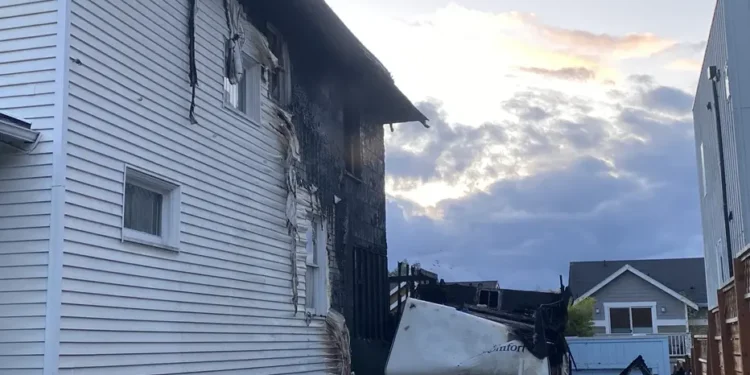Investigators say a man’s fentanyl addiction may have prompted him to set a fire in a travel trailer that burned his family’s home next door.
The fire occurred on Ashworth Avenue North in Wallingford just before 10 p.m. Sunday.
The travel trailer where investigators say the fire originated is completely destroyed. Neighbors report it ignited rapidly and spread quickly.
Police say a 44-year-old man admitted to setting the fire in his trailer before it jumped to his grandmother’s home, which sits just inches away from where he was parked.
“They upgraded it to a 211 quickly and it took about 45 minutes to be fully extinguished,” said Hilton Almond, firefighter and public information officer for the Seattle Fire Department.
Neighbors like Gerardo Pena were shocked by the extent of damage to the home beside the trailer.
“It was way more substantial than what I was suspecting,” Pena said.
Police reports state the suspect told two different stories to officers. First, they say he told them he was a “packrat” and that the fire started accidentally inside the trailer. The report states the man claimed “he had been using an electric hotplate attached to an extension cord to keep warm.”
Later, officers say he told them unprompted that “he had intentionally set the fire in an attempt to kill himself because he was addicted to Fentanyl.”
He told officers “he had poured sanitizer into a garbage bag containing trash, then used a torch lighter to set it on fire while he was still inside the trailer.”
“That’s scary. You hate to see that kind of activity where people are kind of making choices like that,” said Pena.
With so many homes built very close together on the block, Pena feels it could have spread even further without the quick firefighter response.
“Very scary. Densely populated, popular neighborhood, apartments, condos, everything, so I’m glad nobody got hurt,” said Pena.
Neighbors say they saw the suspect’s grandmother escape the home safely. The Red Cross reports three people were displaced.
The suspect is expected in court Tuesday afternoon.
The 44-year-old suspect’s admission to intentionally setting the fire transforms the incident from accidental blaze to arson with potential attempted murder charges if prosecutors determine he knowingly endangered his grandmother and neighbors.
The fentanyl addiction motivation reveals how opioid crisis drives desperate behavior including self-harm attempts that endanger others, with the suspect’s suicidal ideation manifesting in fire-setting that threatened an entire residential block.
The travel trailer’s complete destruction indicates intense heat and rapid fuel consumption where accumulated belongings, propane tanks, and synthetic materials created inferno conditions that quickly overwhelmed the small space.
The grandmother’s home sitting “just inches away” from the parked trailer demonstrates dangerous proximity where property line regulations or informal family arrangements placed structures so close that fire spread became inevitable once flames breached the trailer.
The initial “packrat” story claiming accidental fire from an electric hotplate represents common deflection where suspects minimize culpability by blaming equipment malfunctions rather than admitting intentional fire-setting that carries severe criminal penalties.
The unprompted confession to intentional fire-setting suggests either guilt overwhelming the suspect’s initial deception or psychological need to articulate suicidal motivations rather than maintaining the accidental fire narrative.
The sanitizer-soaked garbage bag ignited with a torch lighter demonstrates deliberate fire-starting methodology rather than impulsive action, with the suspect’s account indicating he understood the flammable liquid would accelerate combustion.
The “attempt to kill himself” while “still inside the trailer” reveals suicide-by-fire intention that failed when survival instincts or changing circumstances caused the suspect to exit before flames consumed him, instead endangering his grandmother.
The 211 alarm upgrade indicates Seattle Fire Department’s recognition that initial response resources proved insufficient, with additional engines, ladder trucks, and personnel summoned to prevent fire spread to surrounding structures.
The 45-minute full extinguishment duration reflects challenges firefighters faced accessing flames within the destroyed trailer and preventing rekindling in the damaged home, requiring thorough overhaul to ensure no hidden embers remained.
Gerardo Pena’s shock at damage extent illustrates how fire’s external appearance during active burning often understates structural compromise, with internal damage from heat and smoke far exceeding what neighbors observe from the street.
The Wallingford neighborhood’s dense housing concentration creates exposure risks where single-family homes, apartments, and condos built on small lots provide limited fire breaks, meaning one structure’s blaze can rapidly spread to multiple properties.
The grandmother’s safe escape despite her home’s proximity to the fire origin suggests either early warning from neighbors or smoke alarms that provided sufficient time to evacuate before flames blocked exits.
The Red Cross displacement of three people indicates the grandmother likely lived with other family members, all now homeless and requiring emergency shelter, clothing, and financial assistance while insurance claims process or rebuilding occurs.
The Tuesday afternoon court appearance will likely involve bail determination where judges weigh the suspect’s flight risk, public safety danger, and whether mental health or substance abuse treatment represents better intervention than pretrial detention.
The arson charges potentially include first-degree arson for intentionally burning an occupied structure, reckless endangerment for threatening grandmother and neighbors, and potentially attempted murder if prosecutors argue he knew his actions would endanger others.
The fentanyl addiction defense may influence sentencing where courts consider substance abuse treatment programs rather than maximum imprisonment, though intentional nature of fire-setting limits mitigating factors compared to accidental blazes.
Ashworth Avenue North’s Wallingford location places the incident in a neighborhood transitioning from single-family homes to higher-density development, where older properties and newer apartments create complex fire response scenarios.
The travel trailer residence suggests the suspect experienced housing instability or family dynamics where living in a recreational vehicle on his grandmother’s property represented his only accommodation option, potentially exacerbating mental health and addiction struggles.
Seattle’s growing fentanyl crisis manifests in incidents like this where addiction drives irrational behavior endangering innocent parties, illustrating how opioid epidemic impacts extend beyond individual users to threaten entire communities.







